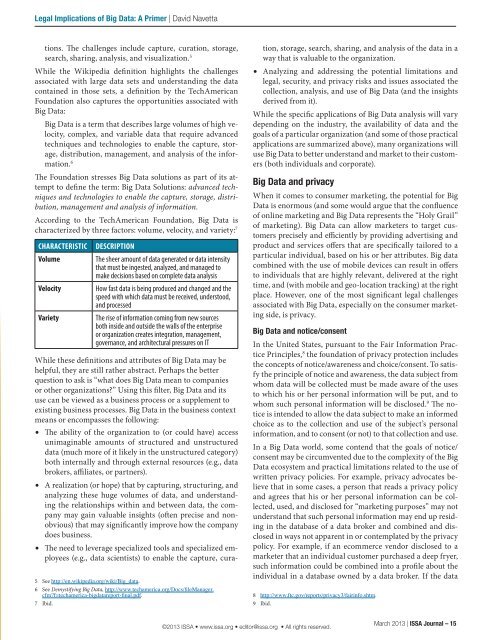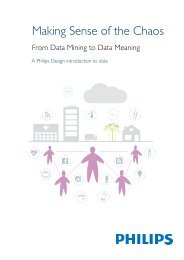1ihHZ6h
1ihHZ6h
1ihHZ6h
You also want an ePaper? Increase the reach of your titles
YUMPU automatically turns print PDFs into web optimized ePapers that Google loves.
Legal Implications of Big Data: A Primer | David Navetta<br />
tions. The challenges include capture, curation, storage,<br />
search, sharing, analysis, and visualization. 5<br />
While the Wikipedia definition highlights the challenges<br />
associated with large data sets and understanding the data<br />
contained in those sets, a definition by the TechAmerican<br />
Foundation also captures the opportunities associated with<br />
Big Data:<br />
Big Data is a term that describes large volumes of high velocity,<br />
complex, and variable data that require advanced<br />
techniques and technologies to enable the capture, storage,<br />
distribution, management, and analysis of the information.<br />
6<br />
The Foundation stresses Big Data solutions as part of its attempt<br />
to define the term: Big Data Solutions: advanced techniques<br />
and technologies to enable the capture, storage, distribution,<br />
management and analysis of information.<br />
According to the TechAmerican Foundation, Big Data is<br />
characterized by three factors: volume, velocity, and variety: 7<br />
CHARACTERISTIC<br />
Volume<br />
Velocity<br />
Variety<br />
DESCRIPTION<br />
The sheer amount of data generated or data intensity<br />
that must be ingested, analyzed, and managed to<br />
make decisions based on complete data analysis<br />
How fast data is being produced and changed and the<br />
speed with which data must be received, understood,<br />
and processed<br />
The rise of information coming from new sources<br />
both inside and outside the walls of the enterprise<br />
or organization creates integration, management,<br />
governance, and architectural pressures on IT<br />
While these definitions and attributes of Big Data may be<br />
helpful, they are still rather abstract. Perhaps the better<br />
question to ask is “what does Big Data mean to companies<br />
or other organizations” Using this filter, Big Data and its<br />
use can be viewed as a business process or a supplement to<br />
existing business processes. Big Data in the business context<br />
means or encompasses the following:<br />
• The ability of the organization to (or could have) access<br />
unimaginable amounts of structured and unstructured<br />
data (much more of it likely in the unstructured category)<br />
both internally and through external resources (e.g., data<br />
brokers, affiliates, or partners).<br />
• A realization (or hope) that by capturing, structuring, and<br />
analyzing these huge volumes of data, and understanding<br />
the relationships within and between data, the company<br />
may gain valuable insights (often precise and nonobvious)<br />
that may significantly improve how the company<br />
does business.<br />
• The need to leverage specialized tools and specialized employees<br />
(e.g., data scientists) to enable the capture, cura-<br />
5 See http://en.wikipedia.org/wiki/Big_data.<br />
6 See Demystifying Big Data, http://www.techamerica.org/Docs/fileManager.<br />
cfmf=techamerica-bigdatareport-final.pdf.<br />
7 Ibid.<br />
tion, storage, search, sharing, and analysis of the data in a<br />
way that is valuable to the organization.<br />
• Analyzing and addressing the potential limitations and<br />
legal, security, and privacy risks and issues associated the<br />
collection, analysis, and use of Big Data (and the insights<br />
derived from it).<br />
While the specific applications of Big Data analysis will vary<br />
depending on the industry, the availability of data and the<br />
goals of a particular organization (and some of those practical<br />
applications are summarized above), many organizations will<br />
use Big Data to better understand and market to their customers<br />
(both individuals and corporate).<br />
Big Data and privacy<br />
When it comes to consumer marketing, the potential for Big<br />
Data is enormous (and some would argue that the confluence<br />
of online marketing and Big Data represents the “Holy Grail”<br />
of marketing). Big Data can allow marketers to target customers<br />
precisely and efficiently by providing advertising and<br />
product and services offers that are specifically tailored to a<br />
particular individual, based on his or her attributes. Big data<br />
combined with the use of mobile devices can result in offers<br />
to individuals that are highly relevant, delivered at the right<br />
time, and (with mobile and geo-location tracking) at the right<br />
place. However, one of the most significant legal challenges<br />
associated with Big Data, especially on the consumer marketing<br />
side, is privacy.<br />
Big Data and notice/consent<br />
In the United States, pursuant to the Fair Information Practice<br />
Principles, 8 the foundation of privacy protection includes<br />
the concepts of notice/awareness and choice/consent. To satisfy<br />
the principle of notice and awareness, the data subject from<br />
whom data will be collected must be made aware of the uses<br />
to which his or her personal information will be put, and to<br />
whom such personal information will be disclosed. 9 The notice<br />
is intended to allow the data subject to make an informed<br />
choice as to the collection and use of the subject’s personal<br />
information, and to consent (or not) to that collection and use.<br />
In a Big Data world, some contend that the goals of notice/<br />
consent may be circumvented due to the complexity of the Big<br />
Data ecosystem and practical limitations related to the use of<br />
written privacy policies. For example, privacy advocates believe<br />
that in some cases, a person that reads a privacy policy<br />
and agrees that his or her personal information can be collected,<br />
used, and disclosed for “marketing purposes” may not<br />
understand that such personal information may end up residing<br />
in the database of a data broker and combined and disclosed<br />
in ways not apparent in or contemplated by the privacy<br />
policy. For example, if an ecommerce vendor disclosed to a<br />
marketer that an individual customer purchased a deep fryer,<br />
such information could be combined into a profile about the<br />
individual in a database owned by a data broker. If the data<br />
8 http://www.ftc.gov/reports/privacy3/fairinfo.shtm.<br />
9 Ibid.<br />
©2013 ISSA • www.issa.org • editor@issa.org • All rights reserved.<br />
March 2013 | ISSA Journal – 15



